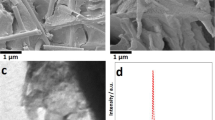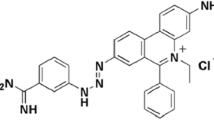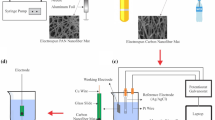Abstract
In recent years, there have been concerns about the toxicity of bisphenol A (BPA) in food packaging materials due to the potential endocrine disrupting effects it may have on humans, especially children and infants. In this present investigation, a free-standing nickel-copper pyridine-2,6-dicarboxylic acid (PDA) metal organic framework (MOF) anchored carbon nanofiber paper (Ni-Cu(PDA)MOF/CNF) was synthesized for the sensing and quantify the BPA analytes in milk and water. As-prepared bimetallic MOF hybrid materials are extremely porous, hydrophilic in nature with a huge surface area. This allows for the easy pathway of analyte molecules, which react with the redox-active metal sites of MOF matrix and enhance the sensitivity. During electrocatalysis reaction, various functional groups present in the MOF system can also act as dynamic adsorption sites. In the neutral medium (pH = 7.0), the Ni-Cu(PDA)MOF/CNF modified glassy carbon electrode (Ni-Cu(PDA)MOF/CNF/GCE) ascertained good catalytic activity and strong electrochemical sensitivity toward BPA with higher sensitivity value and lower limit of detection (LOD) value. The irreversible and diffusion-controlled oxidation reactions of BPA were observed. The bimetallic MOF modified electrode displayed an extensive linear ranging from 1 to 150 µmol/L with a LOD of 75 n mol/L for BPA detection. The MOF anchored electrode displayed exceptional anti-interference property, reproducibility and good storage stability up to one month. It is notable that the Ni-Cu(PDA)MOF/CNF/GCE has proved the competence of detecting BPA in milk and drinking water samples, which displayed satisfactory outcomes with chromatographic analysis.










Similar content being viewed by others
Data availability
Not applicable.
References
Zhang Y, Lei Y, Lu H, Shi L, Wang P, Ali Z, Li J. Electrochemical detection of bisphenols in food: a review. Food Chem. 2021;346:128895.
Gallo P, Di Marco PI, Esposito F, Fasano E, Scognamiglio G, Mita GD, Cirillo T. Determination of BPA, BPB, BPF, BADGE and BFDGE in canned energy drinks by molecularly imprinted polymer cleaning up and UPLC with fluorescence detection. Food Chem. 2017;220:406–12.
Loffredo LF, Coden ME, Berdnikovs S. Endocrine disruptor bisphenol A (BPA) triggers systemic para-inflammation and is sufficient to induce airway allergic sensitization in mice. Nutrients. 2020;12:343.
Huang YQ, Wong CKC, Zheng JS, Bouwman H, Barra R, Wahlström B, Neretin L, Wong MH. Bisphenol A (BPA) in China: a review of sources, environmental levels, and potential human health impacts. Environ Int. 2012;42:91–9.
Dhanjai SA, Wu L, Lu X, Chen J, Jain R. Advances in sensing and biosensing of bisphenols: a review. Anal Chim Acta. 2018;998:1–27.
Mercogliano R, Santonicola S. Investigation on bisphenol A levels in human milk and dairy supply chain: a review. Food Chem Toxicol. 2018;114:98–107.
Santovito A, Cannarsa E, Schleicherova D, Cervella P. Clastogenic effects of bisphenol A on human cultured lymphocytes. Hum Exp Toxicol. 2017;37:69–77.
Wang DX, Wang XC, Hu QJ, Zhang CX, Li F, Wang FL, Feng QU. Salting-out assisted liquid-liquid extraction coupled to dispersive liquid-liquid microextraction for the determination of bisphenol A and six analogs (B, E, F, S, BADGE, BFDGE) in canned coffee drinks by ultra-performance liquid chromatography-tandem mass spectrometry. Food Anal Methods. 2021;14:441–52.
Sun Y, Huang J, Shan L, Fan S, Zhu Z, Liu X. Quantitative analysis of bisphenol analogue mixtures by terahertz spectroscopy using machine learning method. Food Chem. 2021;352:129313.
Zeng L, Cui H, Chao J, Huang K, Wang X, Zhou Y, **g T. Colorimetric determination of tetrabromobisphenol A based on enzyme-mimicking activity and molecular recognition of metal-organic framework-based molecularly imprinted polymers. Microchim Acta. 2020;187:142.
Zhuang YF, Cao GP, Mao JY, Liu BL. Determination of bisphenol A by synchronous fluorimetry using procaine hydrochloride as self-quenching fluorescence probe. J Appl Spectrosc. 2019;85:1094–100.
Lu Y, Peterson JR, Gooding JJ, Lee NA. Development of sensitive direct and indirect enzyme-linked immunosorbent assays (ELISAs) for monitoring bisphenol-A in canned foods and beverages. Anal Bioanal Chem. 2012;403:1607–18.
Wang X, Shi Y, Shan J, Zhou H, Li M. Electrochemical sensor for determination of bisphenol A based on MOF-reduced graphene oxide composites coupled with cetyltrimethylammonium bromide signal amplification. Ionics. 2020;26:3135–46.
Wang KP, Hu JM, Zhang X. Sensitive electrochemical detection of endocrine disruptor bisphenol A (BPA) in milk based on iodine-doped graphene. Microchem J. 2022;173:107047.
Amiri M, Moghaddam HM. Green synthesis of ZnO/ZnCo2O4 and its application for electrochemical determination of bisphenol A. Microchem J. 2021;160:105663.
Li H, Zhu F, **ang J, Wang F, Liu Q, Chen X. In situ growth of ZIF-8 on gold nanoparticles/magnetic carbon nanotubes for the electrochemical detection of bisphenol A. Anal Methods. 2021;13:2338–44.
Karthika P, Shanmuganathan S, Viswanathan S, Delerue-Matos C. Molecularly imprinted polymer-based electrochemical sensor for the determination of endocrine disruptor bisphenol-A in bovine milk. Food Chem. 2021;363:130287.
Lu K, Aung T, Guo N, Weichselbaum R, Lin W. Nanoscale metal-organic frameworks for therapeutic, imaging, and sensing applications. Adv Mater. 2018;30:1707634.
Dey B, Ahmad MW, Sarkhel G, Yang DJ, Choudhury A. Fabrication of porous nickel (II)-based MOF@ carbon nanofiber hybrid mat for high-performance non-enzymatic glucose sensing. Mater Sci Semicond Process. 2022;142:106500.
Ahmad MW, Dey B, Sarkhel G, Yang DJ, Choudhury A. Sea-urchin-like cobalt-MOF on electrospun carbon nanofiber mat as a self-supporting electrode for sensing of xanthine and uric acid. J Electroanal Chem. 2022;920:116646.
Dey B, Ahmad MW, Sarkhel G, Lee GH, Choudhury A. Fabrication of niobium metal organic frameworks anchored carbon nanofiber hybrid film for simultaneous detection of xanthine, hypoxanthine and uric acid. Microchem J. 2023;186:108295.
Xu X, Shi W, Li P, Ye S, Ye C, Ye H, Lu T, Zheng A, Zhu J, Xu L, Zhong M, Cao X. Facile fabrication of three-dimensional graphene and metal-organic framework composites and their derivatives for flexible all-solid-state supercapacitors. Chem Mater. 2017;29:6058–65.
Xu C, Liu L, Wu C, Wu K. Unique 3D heterostructures assembled by quasi-2D Ni-MOF and CNTs for ultrasensitive electrochemical sensing of bisphenol A. Sens Actuators B: Chem. 2020;310:127885.
Wang F, Chen X, Chen L, Yang J, Wang Q. High-performance non-enzymatic glucose sensor by hierarchical flower-like nickel (II)-based MOF/carbon nanotubes composite. Mater Sci Eng C. 2019;96:41–50.
Lin J, Hassan M, Bo X, Guo L. Synthesis of iron-based metal-organic framework@large mesoporous carbon composites and their electrocatalytic properties. J Electroanal Chem. 2017;801:373–80.
Dey B, Sarkhel G, Choudhury A. Facile synthesis of copper MOF/carbon nanofiber nanocomposite paper for electrochemical detection of toxic 4-nitrophenol. J Macromol Sci A. 2023;60:1–11.
Zhang J, Xu X, Chen L. An ultrasensitive electrochemical bisphenol A sensor based on hierarchical Ce-metal-organic framework modified with cetyltrimethylammonium bromide. Sens Actuators B: Chem. 2018;261:425–33.
Huang D, Huang X, Chen J, Ye R, Lin Q, Chen S. An electrochemical bisphenol: a sensor based on bimetallic Ce-Zn-MOF. Electrocatalysis. 2021;12:456–68.
Huang X, Huang D, Chen JY, Ye R, Lin Q, Chen S. Fabrication of novel electrochemical sensor based on bimetallic Ce-Ni-MOF for sensitive detection of bisphenol A. Anal Bioanal Chem. 2020;412:849–60.
Schubert DM, Visi MZ, Knobler CB. Acid-catalyzed synthesis of zinc imidazolates and related bimetallic metal-organic framework compounds. Main Group Chem. 2018;7:311–22.
**ng H, Peng S, Zeyi T, Zhang F, Wang J, Geng H, Zou D, Di C, Yi Y, Sun Y, Xu W. A two-dimensional π–d conjugated coordination polymer with extremely high electrical conductivity and ambipolar transport behavior. Nat Commun. 2015;6:7408.
Zhang X, Xu Y, Ye B. An efficient electrochemical glucose sensor based on porous nickel based metal organic framework/carbon nanotubes composite (Ni-MOF/CNTs). J Alloys Compd. 2018;767:651–6.
Wang X, Wang Q, Wang Q, Gao F, Gao F, Yang Y, Guo H. Highly dispersible and stable copper terephthalate metal–organic framework–graphene oxide nanocomposite for an electrochemical sensing application. ACS Appl Mater Interfaces. 2014;6:11573–80.
Manh BN, Nhung VTH, Thu VT, Nga DTN, Thuan NPT, Giang HT, Yen PTH, Phong PH, Tuan AV, Ha VTT. An electrochemical sensor based on copper-based metal–organic framework-reduced graphene oxide composites for determination of 2,4-dichlorophenol in water. RSC Adv. 2020;10:42212–20.
Ahmad MW, Choudhury A, Dey B, Anand S, Al Saidi AKA, Lee GH, Yang DJ. Three-dimensional core-shell niobium-metal organic framework@ carbon nanofiber mat as a binder-free positive electrode for asymmetric supercapacitor. J Energy Storage. 2022;55:105484.
Ranjbar M, Taher MA, Sam A. Facile hydrothermal synthesis of manganese-metal organic framework nanostructures in the presence of various organic ligands for SO2 and CO2 gas adsorption. J Porous Mater. 2016;23:375–80.
Rzaczynska Z, Danczowska-Burdon A, Sienkiewicz-Gromiuk J. Thermal and spectroscopic properties of light lanthanides(III) and sodium complexes of 2, 5-pyridinedicarboxylic acid. J Therm Anal Calorim. 2010;101:671–7.
Murinzi TW, Hosten E, Watkins GM. Synthesis and characterization of a cobalt-2, 6-pyridinedicarboxylate MOF with potential application in electrochemical sensing. Polyhedron. 2017;137:188–96.
Thong CH, Priyanga N, Ng FL, Pappathi M, Periasamy V, Phang SM, Kumar GG. Metal organic frameworks (MOFs) as potential anode materials for improving power generation from algal biophotovoltaic (BPV) platforms. Catal Today. 2022;397–399:419–27.
Salmanion M, Najafpour MM. Structural changes of a NiFe-based metal-organic framework during the oxygen-evolution reaction under alkaline conditions. Int J Hydrog Energy. 2021;46:19245–53.
Abd El Salam HM, Zaki T. Removal of hazardous cationic organic dyes from water using nickel-based metal-organic frameworks. Inorg Chim Acta. 2018;471:203–10.
Xu W, Liu M, Wang S, Peng Z, Shen R, Li B. Interfacial ensemble effect of copper nanoparticles and nickel metal-organic framework on promoting hydrogen generation. Int J Hydrog Energy. 2022;47:23213–20.
Cai J, Sun B, Li W, Gou X, Gou Y, Li D, Hu F. Novel nanomaterial of porous graphene functionalized black phosphorus as electrochemical sensor platform for bisphenol A detection. J Electroanal Chem. 2019;835:1–9.
Zhang B, Wang Y, Dai X, Liu D, He X. A nitrogen and sulfur co-doped graphene-supported nickel tetrapyridyloxyphthalocyanine hybrid fabricated by a solvothermal method and its application for the detection of bisphenol A. RSC Adv. 2015;5:84457–64.
Laviron E. General expression of the linear potential sweep voltammogram in the case of diffusion less electrochemical systems. J Electroanal Chem. 1979;101:19–28.
Zhu L, Cao Y, Cao G. Electrochemical sensor based on magnetic molecularly imprinted nanoparticles at surfactant modified magnetic electrode for determination of bisphenol A. Biosens Bioelectron. 2014;54:258–61.
Portaccio M, Di Tuoro D, Arduini F, Moscone D, Cammarota M, Mita DG, Lepore M. Laccase biosensor based on screen-printed electrode modified with thionine–carbon black nanocomposite for bisphenol A detection. Electrochim Acta. 2013;109:340–7.
Ndlovu T, Arotiba OA, Sampath S, Krause RW, Mamba BB. An exfoliated graphite-based bisphenol A electrochemical sensor. Sensors. 2012;12:11601–11.
Jodar LV, Orzari LO, Storti Ortolani T, Assumpç˜ao MH, Vicentini FC, Janegitz BC. Electrochemical sensor based on casein and carbon black for bisphenol A detection. Electroanalysis. 2019;31:2162–70.
Baccarin M, Ciciliati M, Oliveira ON, Cavalheiro ETG, Raymundo-Pereira PA. Pen sensor made with silver nanoparticles decorating graphite-polyurethane electrodes to detect bisphenol-A in tap and river water samples. Mater Sci Eng C. 2020;114:110989.
Jebril S, Cubillana-Aguilera L, Palacios-Santander JM, Dridi C. A novel electrochemical sensor modified with green gold sono-nanoparticles and carbon black nanocomposite for bisphenol A detection. Mater Sci Eng B. 2021;264:114951.
Mazzotta E, Malitesta C, Margapoti E. Direct electrochemical detection of bisphenol A at PEDOT-modified glassy carbon electrodes. Anal Bioanal Chem. 2013;405:3587–92.
Li H, Wang W, Lv Q, ** G, Bai H, Zhang Q. Disposable paper-based electrochemical sensor based on stacked gold nanoparticles supported carbon nanotubes for the determination of bisphenol A. Electrochem Commun. 2016;68:104–7.
Wang Y, Yin C, Zhuang Q. An electrochemical sensor modified with nickel nanoparticle/nitrogen-doped carbon nanosheet nanocomposite for bisphenol A detection. J Alloys Compd. 2020;827:154335.
Ren J, Kang TF, Xue R, Ge CN, Cheng SY. Biosensor based on a glassy carbon electrode modified with tyrosinase immmobilized on multiwalled carbon nanotubes. Microchim Acta. 2011;174:303–9.
Chunhuan T, Dandan C, Nali L, Yao L, Rong**g C, Zhida H, Genhua Z. Electrochemical bisphenol A sensor based on nanoporous PtFe alloy and graphene modified glassy carbon electrode. J Electroanal Chem. 2018;830:83127–33.
Sun PY, Wu YH. An amperometric biosensor based on human cytochrome P450 2C9 in polyacrylamide hydrogel films for bisphenol A determination. Sens Actuators B Chem. 2013;178:113–8.
Acknowledgements
This study was supported by the Princess Nourah bint Abdulrahman University as Researchers Supporting Project No. (PNURSP2024R24), Princess Nourah bint Abdulrahman University, Riyadh, Saudi Arabia. This study was also supported via funding from Prince Sattam bin Abdulaziz University Project No. (PSAU/2023/R/1444).
Author information
Authors and Affiliations
Corresponding authors
Ethics declarations
Conflicts of interest
The authors declare no conflict of interest.
About this article
Cite this article
Dey, B., Ahmad, M.W., Al-Shannaq, R. et al. Non-Enzymatic Electrochemical Sensing of Bisphenol A in Drinking Water and Milk Using Bimetallic Nickel-Copper Metal–Organic Framework. J. Anal. Test. (2024). https://doi.org/10.1007/s41664-024-00312-3
Received:
Accepted:
Published:
DOI: https://doi.org/10.1007/s41664-024-00312-3




